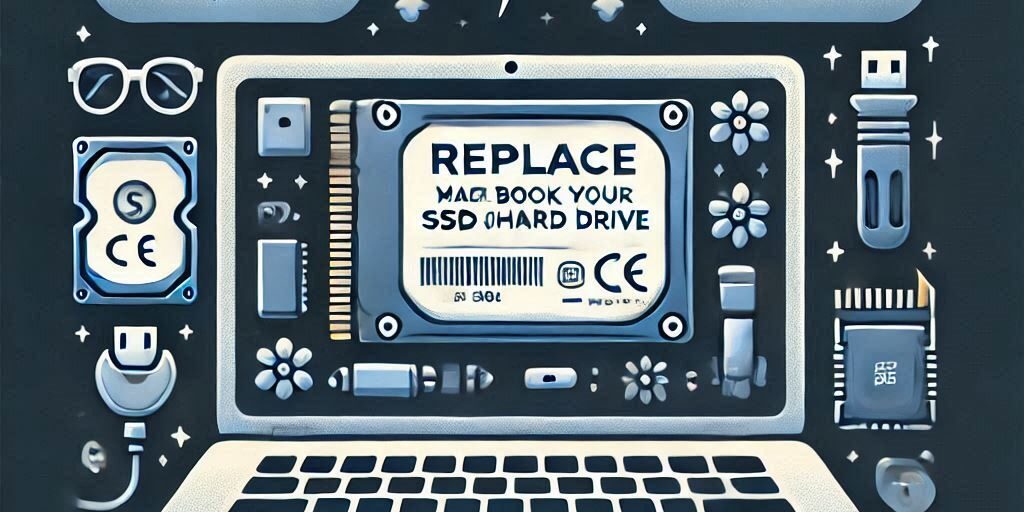Your MacBook’s SSD or hard drive plays a vital role in its overall performance and data storage. Over time, these components can wear out, leading to sluggish performance, data loss, or total failure.
This guide will help you understand the signs of a failing SSD or hard drive, how to diagnose the issue, and steps to replace your storage. By the end, you’ll know whether it’s time for an upgrade or a replacement and how to do it effectively.
Understanding the Role of Your MacBook’s SSD or Hard Drive
1. Differences Between SSDs and Hard Drives
- Hard Drives (HDDs): Use mechanical parts to read/write data. They’re cost-effective but slower and more prone to failure.
- Solid State Drives (SSDs): Use flash memory for faster data access, increased durability, and quieter operation.
2. Benefits of SSDs Over Traditional Hard Drives
- Faster boot times and app launches
- Better resistance to physical shocks
- Lower energy consumption
Signs You Need to Replace Your MacBook’s SSD or Hard Drive
1. Slow Boot Times and Application Launches
A noticeable decline in speed during startup or when opening applications can indicate failing storage.
2. Frequent Freezes or Crashes
Random system freezes or crashes might be caused by corrupted storage sectors.
3. Unusual Noises from the Hard Drive
Clicking or grinding sounds are a clear indication of mechanical failure in hard drives.
4. Errors While Reading or Writing Data
Frequent error messages when transferring files may point to failing storage.
Steps to Diagnose a Failing SSD or Hard Drive
1. Using macOS Built-in Tools
- Open Disk Utility and use the First Aid feature to check and repair disk issues.
2. Checking Storage Health with Third-Party Applications
- Use apps like DriveDx to monitor SSD health metrics, including wear levels and bad sectors.
3. Monitoring System Performance
- Check Activity Monitor to identify any unusual storage activity or slow read/write speeds.
Choosing the Right Replacement for Your MacBook
1. Deciding Between an SSD and a Hard Drive
- Choose an SSD: For better speed, reliability, and energy efficiency.
- Stick with HDDs: If you need larger storage at a lower cost.
2. Storage Capacity Considerations
- Determine your needs: 256GB for light users, 1TB+ for heavy users with large files.
3. Compatibility with Your MacBook Model
- Ensure the replacement drive matches your MacBook’s specifications.
How to Replace Your MacBook’s SSD or Hard Drive
1. Backing Up Your Data
- Use Time Machine or an external drive to create a complete backup.
2. Accessing the Internal Components Safely
- Use appropriate tools to open the MacBook and avoid static discharge by grounding yourself.
3. Installing the New SSD or Hard Drive
- Remove the old drive carefully, install the new one, and secure it with screws.
4. Restoring macOS and Data
- Reinstall macOS using a bootable USB drive and restore your data from the backup.
Upgrading vs. Replacing: Which is Right for You?
1. When to Opt for a Storage Upgrade
- If your current storage is too small but still functional.
2. Benefits of Replacing Aging Hardware
- Improved speed and reliability
- Reduced risk of sudden failures
Preventing Storage Failures in the Future
1. Regular Backups
- Schedule backups using Time Machine to safeguard your data.
2. Monitoring Storage Health
- Periodically check storage health using Disk Utility or third-party tools.
3. Maintaining Adequate Free Space
- Keep at least 20% of your storage free for optimal performance.
When to Seek Professional Help
1. Recognising Complex Issues
- If the problem persists after replacing or upgrading your drive, consult an expert.
2. Finding Reliable Repair Services
- Trust professionals like Perth Computer Experts for hassle-free replacements.
Conclusion and Call to Action
Recognising when to replace your MacBook’s SSD or hard drive is crucial to maintaining its performance and reliability. By understanding the signs, diagnosing the issue, and choosing the right replacement, you can ensure your MacBook continues to perform at its best.
If you’re unsure or need assistance, Perth Computer Experts is here to help. Contact us today for expert advice and fast, reliable MacBook storage solutions!




